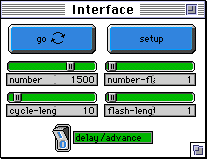
WHAT IS IT? ----------- This model demonstrates a population of fireflies which synchronize their flashing using only the interactions between the individual fireflies. It is a good example of how a distributed system (i.e. a system with many interacting elements, but no 'leader') can coordinate itself without any central coordinator. Each firefly constantly cycles through its own clock, flashing at the beginning of each cycle and then resetting the clock to zero once it has reached the maximum. At the start of each simulation all fireflies begin at a random point in their cycles (though they all have the same cycle lengths) and so flashing will occur erratically through the population. As fireflies perceive other flashes around them they are able to use this information to reset their own clocks to try and synchronize with the other fireflies in their vicinity. Each firefly uses the same set of rules to govern its own clock, and depending on the parameters of the simulation, the population may synchronize more or less effectively. Though most species of firefly are not generally known to synchronize in groups, there are some (for example, Pteroptyx cribellata, Luciola pupilla, Pteroptyx malaccae) that have been observed to do so in certain settings. This model generalizes two main strategies used by such insects to synchronize with each other (phase-delay and phase-advance synchronization, as described below), retaining the essentials of the strategies while downplaying biological detail. HOW TO USE IT? -------------- GO: starts and stops the simulation. SETUP: resets the simulation according to the parameters set by the sliders. NUMBER: sets the number of fireflies to be created. CYCLE-LENGTH: sets the length of each firefly's clock before it resets to 0. NUMBER-FLASHES: sets the number of flashes a firefly must see in a single tick before its clock resets. FLASH-LENGTH: sets the duration, in ticks, of each flash. DELAY/ADVANCE: sets the synchronization strategy to be used. 0 is phase delay, where upon seeing NUMBER-FLASHES flashes a firefly will reset its clock to the FLASH-LENGTH tick (just after a flash would normally occur). This causes the firefly to synchronize with the next flash of the firefly it is responding to. 1 is phase advance, where upon seeing NUMBER-FLASHES flashes a firefly will reset its clock to zero. This causes the firefly to flash immediately. Under phase-advance, fireflies can only begin to reset their clocks during a window which begins two ticks after they have flashed. This assures that flashes do not get stuck in a short cycle where they persistenly reset their clocks and stay lit indefinitely. All slider settings must be set before pressing the SETUP button. Changes to the sliders will have no effect on a simulation in progress. THINGS TO NOTICE ---------------- Using the default settings (number: 1500, cycle-length: 10, flash-length: 1, number-flashes: 1, delay/advance: 0) notice how local clusters of synchronization begin to form. See if you can figure out where each cluster is represented on the graph. As the simulation proceeds, try to determine which local cluster will eventually 'take over' the population. Did this cluster originally have the highest spike on the graph? In phase-advance simulations, why do the graphs generally top off before the peaks reach the entire population? In this model fireflies cannot reset their cycle when they are in the middle of a flash. Why was this restriction imposed? THINGS TO TRY ------------- Switch DELAY/ADVANCE between phase-delay and phase-advance while keeping the other settings steady (in particular, keep NUMBER-FLASHES at 2). Which strategy seems more effective? Why? Try adjusting NUMBER-FLASHES between 0, 1 and 2 using both phase-delay and phase-advance settings. Notice that each setting will give a characteristically different graph, and some of them do not allow for synchronization at all (for example, with DELAY/ADVANCE set to 1, contrast NUMBER-FLASHES set to 1 as opposed to 2). Why does this control make such a difference in the outcome of the simulation? Changing the number of fireflies in a simulation affects the density of the population (as does adjusting the size of the graphics screen). What effect does this have on a simulation? EXTENDING THE MODEL ------------------- This model explores only two general strategies for attaining synchrony in such cycle-governed fireflies. Can you find any others? Can you improve the existing strategies (i.e., by speeding them up)? There are many other possible situations in which distributed agents must synchronize their behavior through the the use of simple rules. What if, instead of perceiving only other discrete flashes, an insect could sense where another insect was in its cycle (perhaps by hearing an increasingly loud hum)? What kinds of strategies for synchronization might be useful in such a situation? If all fireflies had adjustable cycle-lengths (initially set to random intervals) would it then be possible to coordinate both their cycle-lengths and their flashing? REFERENCES ---------- Buck, John. (1988). Synchronous Rhythmic Flashing of Fireflies. The Quarterly Review of Biology, September 1988, 265 - 286. Carlson, A.D. & Copeland, J. (1985). Flash Communication in Fireflies. The Quarterly Review of Biology, December 1985, 415 - 433.